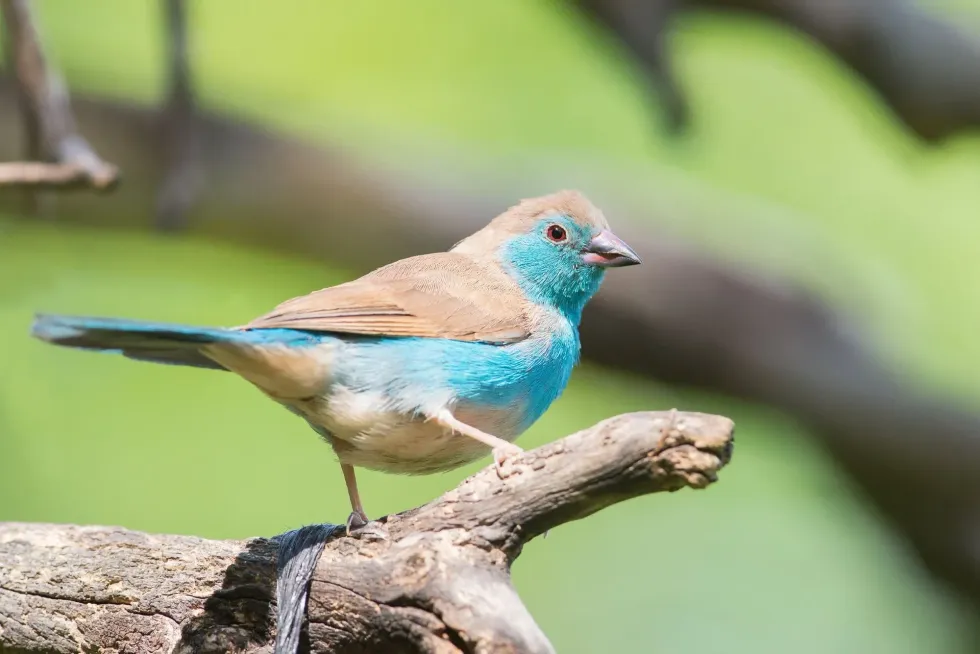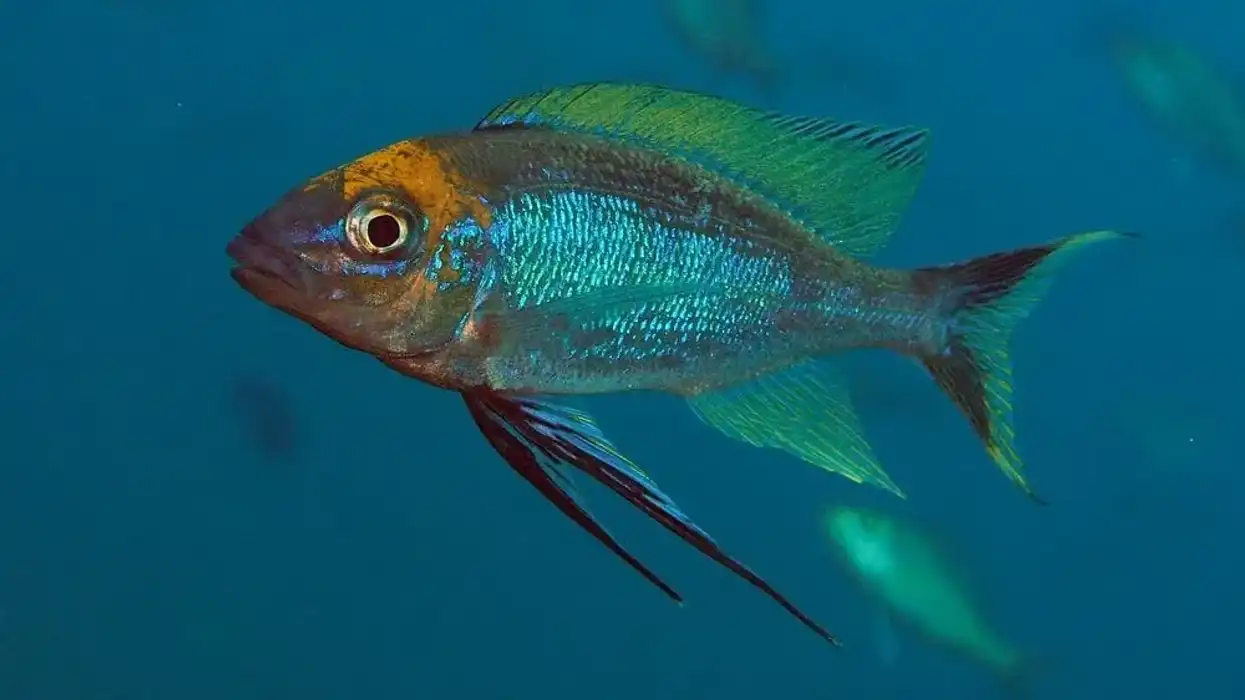Are you planning to keep a colorful bird as a pet? Well, the cordon-bleu finch can be a good choice.
The cordon-bleu finch is native to Africa. However, this small finch can adapt well in captivity under favorable conditions.
It is a beautiful blue and brown colored finch with an average size of 5.1 in (13 cm). The back and wings are brown but become light on the underparts near the breast. Their face, flanks, and tails are sky blue.
The male red-cheeked cordon-bleu exhibits a striking bright red patch on each ear. This bright red patch can quickly help to differentiate cordon-bleu finch males and females.
The blue color in the females is lighter than in the males. Also, the females do not have red spots near the ear. The young cocks also lack the red patch; however, they can be distinguished from the young hen from the deeper blue color.
If you enjoy this article, check out dodo facts and magpie facts!
Cordon-Bleu Finch Interesting Facts
What type of animal is a cordon-bleu finch?
Cordon bleu finches are known to be social birds and live in colonies in the wild. For this reason, when kept in captivity, they need a lot of social interaction with other birds, so they remain happy and healthy.
Your best choice is to keep at least two finches of different sexes together. They can be kept with other bird species like waxbills if the cage is big enough to interact without any conflict.
If you plan to keep a pair of cordon-bleu finches, it is best to keep one pair per cage. They have the habit of abandoning their nest often if they are disturbed.
Corndon-bleu finches are also known to abandon their nest if they are not given enough insects or other protein sources to rear their young ones. Therefore, breeding the finches can be difficult if you do not take proper care.
The song of the cordon-bleu finches is beautiful and healthy birds often like to sing. In contrast, males are known to sing more than females.
What class of animal does a cordon-bleu finch belong to?
The cordon-bleu finch belongs to the class Aves and the family Estrildidae.
How many cordon-bleu finches are there in the world?
The exact number of the cordon-bleu finches is not known. However, many species like red-cheeked cordon-bleu finches (Uraeginthus bengalus), blue-breasted cordon-bleu finches (Uraeginthus angolensis), blue-cap cordon-bleu finches, blue waxbills, white cordon-bleu finches, and so on are known to exist.
Where does a cordon-bleu finch live?
The cordon-bleu finches live in the grasslands, scrubland, villages, and farmland. They are native to Africa.
The blue-breasted cordon-bleu (Uraeginthus angolensis) is found in Southern Africa.
The blue-capped cordon-bleu finch is found in East Africa like Somalia, Tanzania, and Ethiopia.
The red-cheeked cordon-bleu finch (Uraeginthus bengalus) is distributed in central and eastern Africa. It ranges from west African countries like Gambia, Mauritania, Senegal to Mali, Niger, southern Sudan, and southern Chad to Ethiopia, Somalia, Angola, the Democratic Republic of the Congo (southern Kasai and Katanga), Tanzania, Zambia, and Mozambique.
The red-cheeked cordon-bleu finch (Uraeginthus bengalus) has also been introduced in the islands of Hawaii and Oahu.
What is a cordon-bleu finch's habitat?
The habitat of the cordon-bleu finches comprises savannahs or low grasses with thorn scrub, dry acacia woodland, and cultivated areas near the villages.
The blue-capped cordon-bleu and the red-cheeked cordon-bleu inhabit shrublands, subtropical or tropical dry grasslands, and deserts of Subsaharan Africa.
The blue waxbill or blue-breasted cordon-bleu (Uraeginthus angolensis) occurs in different habitats but usually prefers well-watered and semi-arid savannah regions where umbrella thorns grow cultivated areas, mopane, and near the edges of the forests.
Who does cordon-bleu finch live with?
Cordon-bleu finches live in pairs or groups.
How long does a cordon-bleu finch live?
The cordon-bleu finch has an average lifespan of seven to nine years. In contrast, owl finches have an average lifespan of five to seven years.
How do they reproduce?
Birds perform sexual reproduction and have internal fertilization. The cock cordon-bleu finch carries nesting material in its mouth and starts to dance on the branch of the trees to display courtship.
The cock will jump from one perch to another, and if possible, make the hen follow him around and both sing. The cordon-bleu finch lays up to three to six eggs and undergoes an incubation period of 12-14 days.
While in captivity, they are not easy to breed. To let the finches breed, you have to provide them with enough nesting materials, and you must take care of their diet. For example, some pet blue-capped cordon-bleus like to nest in round grass huts.
What is their conservation status?
The conservation status of the cordon-bleu finch is Least Concern.
Cordon-Bleu Finch Fun Facts
What does cordon-bleu finch look like?

The cordon-bleu finch has sky blue covering the face, breast, flanks, and tail. It has brown feathering on the wings and the underparts. The beak is pink. However, each of the cordon-bleus has different striking features. The males have more extensive blue feathering than the females.
In cordon-bleus red-cheeked waxbill, blue feathering does not expand till the top. Also, the cock has red cheek patches over the ears. The red patch size varies from male to male.
The blue-breasted waxbill looks similar to the red-cheeked cordon-bleu, except that the male does not have red cheek patches over the ears. Also, they have extensive blue in the breast and sides of the body.
In the blue-capped cordon-bleu, the cock's blue coloring is extended over the top of the head.
How cute are they?
The cordon-bleus are striking little birds native to Africa. Their body, tail, flanks, breast, and tail are covered with blue. The underparts and back wings are covered with brown. The cock's blue coloring is darker than the females'. The young ones resemble the adult females.
How do they communicate?
The cordon-bleus are known to communicate through vocalization. The cordon-bleu finches make loud calls. Both the males and females sing, but the songs of the males are much longer. Songs may vary according to individuals and are often sung to display courtship.
The blue-capped cordon-bleu bird has a musical call. Both the males and females will call and dance.
The cordon-bleu red-cheeked blue finches make a thin and high-pitched call. It is often repeated and is described as 'siii siii' or 'tsee tsee'. The song is complex and has four to six high-pitched notes. The last note is longer, lower, and somewhat prickly. Although rhythmic, the call is lazy. It is described as 'wit-sit-diddley-diddley-ee-ee'.
A red-cheeked cordon-bleu finch female also sings to defend their nesting sites. Their songs are less complex than the males. The females' songs are also related to the breeding season. During the cordon-bleu finch breeding season, when it is the peak time for females to lay eggs, it is known to make calls and build pairs or breeding coordination.
How big is a cordon-bleu finch?
The red-cheeked cordon-bleus (Uraeginthus bengalus) and cordon-bleu blue-breasted (Uraeginthus angolensis) are 4.75 in (12 cm). The blue-capped cordon-bleu species is around 5.25 in (13 cm).
Cordon-bleu finches are two times bigger than the Andean siskin.
How fast can a cordon-bleu finch fly?
The finches are known to fly for 20-30 mph (32.1-48.2 kph).
The red-cheeked cordon-bleus (Uraeginthus bengalus) fly at a height of 7,970 ft (2,430 m) above sea level.
How much does a cordon-bleu finch weigh?
The red-cheeked waxbill and blue-breasted waxbill birds weigh around 10 grams. In contrast, the blue-capped cordon-bleus weighs around 0.024-0.26 lb (11-12 g).
What are the male and female names of the species?
The female cordon-bleu finch bird is known as a hen, and the male cordon-bleu finch bird is known as a cock.
What would you call a baby cordon-bleu finch?
A baby cordon-bleu finch is known as a chick.
What do they eat?
The cordon-bleu bird's diet includes a small seed mix like a mixture of millets, seeding grasses, weed seeds, and sprouted seeds. It is highly insectivorous.
So, its feeding habit comprises live food like ant eggs, waxworms, small mealworms, fruit fly larva, cuttlebone, flying termites, aphids, white worms, and other small insects. Also, often seen feeding on chickweed, dandelion, lettuce, spinach, spray millet, broccoli tops, and carrots. When kept in aviaries, feeding them with proper food is essential.
Are they poisonous?
No, cordon-bleu finches are not poisonous.
Would they make a good pet?
They are famous pet birds with many subspecies available. You can choose the most striking ones.
The red-cheeked waxbill subspecies, blue-capped waxbill, and blue-breasted waxbill subspecies of cordon-bleu birds are friendly, energetic, and easy to take care of. Since they are small, they won't require a big cage or much of the room in your house. However, cordon-bleu birds do best in large planted aviaries or cages with mixed species of birds.
Did you know...
The cost of cordon-bleu finch bird is around $100 (US) per pair.
In the wild, the mating of the cordon-bleu species takes place after the rainy season, i.e., from January to June, when green seeds and termites are available in abundance.
In captivity in Australia, the blue-breasted cordon-bleus mate from February to July, and the blue-capped cordon-bleus mate from March to July.
Even when in captivity, red-cheeked cordon-bleu species are known to breed at any time if they are provided the right temperature, the cage is kept dry, and plenty of live food. But usually, breeding in spring-summer is suggested.
How do you breed finches?
If you plan to breed finches, you should provide them a complete breeding diet, usually one month before the breeding season. Feeding them with a diet that includes live food, green foods, dry seeds, and soft food is essential.
The blue-breasted cordon-bleus and the red-cheeked cordon-bleus can be prepared for breeding before six months of age. But to breed the blue-capped cordon-bleu waxbill, they should be at least twelve months of age due to egg binding and immaturity problems.
During breeding, they make many hideouts. Therefore, it is crucial to provide them with well-planted aviaries or a big cage with plenty of space. Aviaries or a big cage give them enough space to fly. Place only one pair at a time for best results. Avoid placing them with other pairs inside the cage as it will distract them.
Please provide them with half-open nest boxes and hanging baskets for nesting. You should build a nest at 7.5 ft (2.2 m) off the ground. The nesting materials should include fine grass, coconut fiber, moss, and white feathers. Make sure that these nesting materials are available even during the incubation period.
Are they predators?
Yes, the cordon-bleu finches are predatory for those insects on which it feeds.
However, the cordon-bleu finches have predators like eagles, hawks, foxes, weasels, wolves, and other large creatures.
Here at Kidadl, we have carefully created lots of interesting family-friendly animal facts for everyone to discover! Learn more about some other birds from our Cooper's hawk facts and hawk facts pages.
You can even occupy yourself at home by drawing one on our free printable finch coloring pages.









